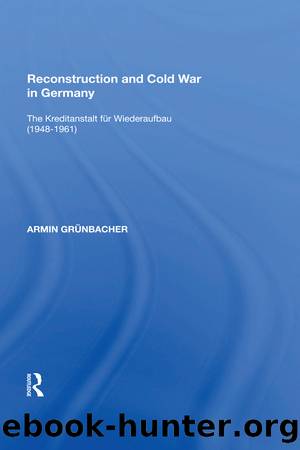Reconstruction and Cold War in Germany by Armin Grünbacher

Author:Armin Grünbacher [Grünbacher, Armin]
Language: eng
Format: epub
Tags: History, General
ISBN: 9781351150620
Google: Fp1ADwAAQBAJ
Publisher: Routledge
Published: 2017-11-28T01:31:47+00:00
Another means to encourage miners to stay was of course pay incentives. When the Nazis had stopped wage increases in 1936 a minerâs average gross pay per hour was RM 1. By 1948 it had increased to DM 1.21 and to DM 2.07 in 1952 and eventually to DM 2.20 in 195472. Minersâ wages were traditionally amongst the highest labour wages in Germany but with the iron and steel sector booming and short of labour, the steel plants could and did offer similarly high wages. Consequently, by 1955 the miners left the pits in increasing numbers to earn the same money for less dangerous and less hard work and most certainly under working conditions which were more favourable than those under-ground73.
The loss of trained labour naturally meant a reduction in productivity and output for the collieries. But with the coal price still fixed, the Unternehmens-verband Ruhrbergbau (UVR), the minesâ employers association, was hardly able to grant the 12 per cent pay rise demanded by the minersâ union in 1955. Despite this, the wage claim was not criticised by the UVR: it was perhaps even secretly welcomed since it gave the pit managers a chance to call for another increase in the coal price. The pay rise would have increased minersâ average hourly pay to DM 2.60. The resulting increased costs plus some extra, the managers hoped, would be covered by a rise of the coal price. Both the minersâ union and the UVR passed the problem to the politicians. Erhard knew that the minersâ wages had to rise to keep them in the pits but he also knew that the average price for coal would rise from DM 62.40 in 1954 to DM 68.60 per ton, increasing first electricity prices and then reduce the margins of the iron and steel industry before it would affect the rest of the economy. In addition, a pay rise for the miners would trigger demands for wage rises in other sectors74. As a response to this wage crisis and to avoid the negative effects of a direct pay rise, the federal government and the government of North Rhine Westphalia started to directly subsidise minersâ wages in October 1956. The so-called Bergmannslohn (minerâs wage) added up to DM 2.50 to a minerâs daily pay at the expense of DM 200 million a year for the tax payer and put the miners back at the top of the wage scale. In addition to this the collieries were allowed a special depreciation for underground machinery and a 6.5 per cent reduction of the Knappschaftsbeiträge, the special minersâ pension funds, again at the taxpayersâ expense. It is doubtful whether the Knappschaften at this stage really needed this subsidy for in November that year they lent the KfW DM 3 million for 15 years75. It was in actual fact nothing but a substitute to reduce wage costs (Lohnersatz).
In 1956 Erhard and the UVR eventually reached their main objective, the abolition of the price fixing by the High Authority and the German government.
Download
This site does not store any files on its server. We only index and link to content provided by other sites. Please contact the content providers to delete copyright contents if any and email us, we'll remove relevant links or contents immediately.
| Belgium | France |
| Germany | Great Britain |
| Greenland | Italy |
| Netherlands | Romania |
| Scandinavia |
Room 212 by Kate Stewart(4741)
The Crown by Robert Lacey(4577)
Endurance: Shackleton's Incredible Voyage by Alfred Lansing(4511)
The Iron Duke by The Iron Duke(4125)
The Rape of Nanking by Iris Chang(4024)
Killing England by Bill O'Reilly(3899)
Joan of Arc by Mary Gordon(3787)
Say Nothing by Patrick Radden Keefe(3730)
I'll Give You the Sun by Jandy Nelson(3274)
Shadow of Night by Deborah Harkness(3178)
Hitler's Monsters by Eric Kurlander(3165)
Mary, Queen of Scots, and the Murder of Lord Darnley by Alison Weir(3070)
Blood and Sand by Alex Von Tunzelmann(3060)
Darkest Hour by Anthony McCarten(3019)
Margaret Thatcher: The Autobiography by Thatcher Margaret(2972)
Eleanor & Park by Rainbow Rowell(2944)
Red Famine: Stalin's War on Ukraine by Anne Applebaum(2816)
Book of Life by Deborah Harkness(2723)
The One Memory of Flora Banks by Emily Barr(2687)
